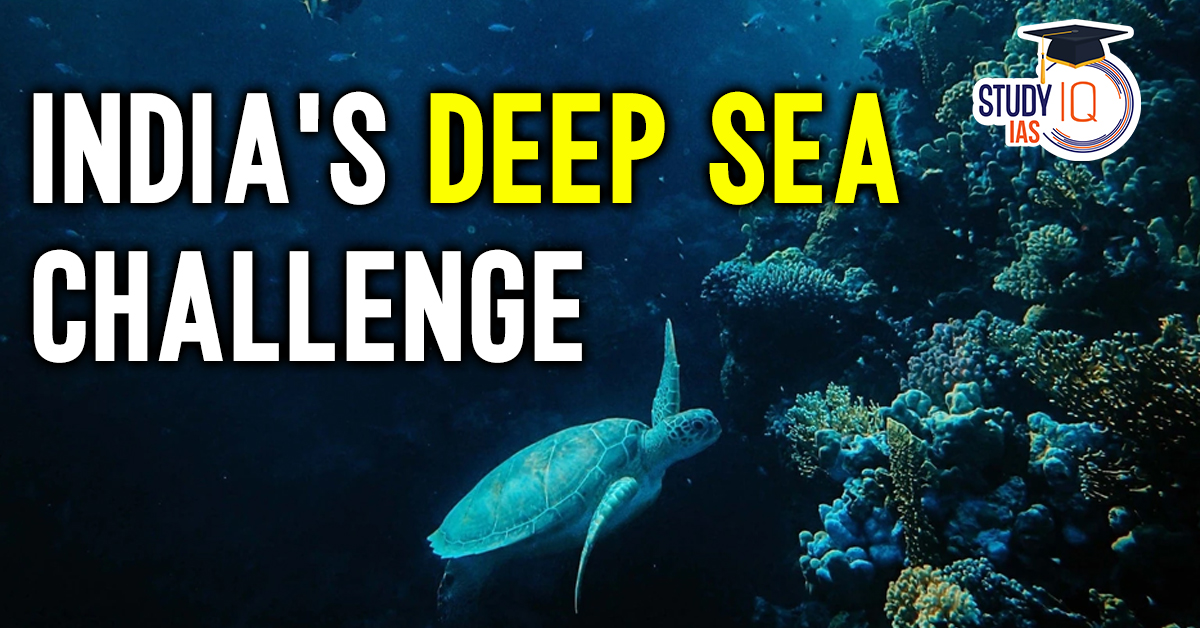Table of Contents
Context: India’s Matsya-6000 submersible aims to enhance deep-sea exploration for resources and security, amid growing geopolitical competition and technological advances in undersea infrastructure and surveillance by nations like China.
More in News
- Matsya-6000 Submersible: India completed wet testing of the Matsya-6000 submersible, capable of diving up to 6 km to explore underwater minerals.
- Its launch later this year will place India among the few nations capable of manned deep-sea exploration.
- China’s Deep-Sea Cable Cutter: China unveiled a compact deep-sea cable-cutting device capable of severing even the most fortified underwater communication and power lines, reinforcing its dominance with the largest fleet of submersibles in the world.
- France and Japan: These countries have successfully commercialized deep-sea mining and undersea infrastructure development through long-term investment and policy support.
Deep Sea Technology: Need
Deep Sea Technology encompasses a range of specialized tools, equipment, and techniques designed for exploring and making use of the ocean’s depths. This technology is essential for marine research, extracting resources, and developing underwater infrastructure.
Harnessing Economic Resources
The ocean holds vast untapped resources:
- Gas hydrates – Potential future energy source.
- Polymetallic nodules – Rich in rare earth metals (manganese, nickel, cobalt).
- Oil and gas reserves – Essential for energy security.
- Nutraceuticals – Bioactive compounds for pharmaceuticals and health products.
- Developing deep-sea technology will enable India to explore and commercially exploit these resources.
Enhancing National Security
Increasing geopolitical competition in the deep sea (e.g., China’s deep-sea cable-cutting device).
- Developing deep-sea surveillance and defence technology is crucial to protect underwater infrastructure and maritime borders.
- Maintaining Underwater Domain Awareness (UDA) is critical for national security and strategic dominance.
Strengthening Communication and Digital Infrastructure
Over 95% of intercontinental internet traffic flows through undersea cables.
- Developing indigenous capability to lay, maintain, and secure undersea cables will ensure digital sovereignty and data security.
- Protecting undersea cables from sabotage and disruption is vital for global connectivity and financial systems.
Supporting the Blue Economy
India’s Exclusive Economic Zone (EEZ) spans 37 million sq km.
- The blue economy can contribute significantly to GDP through:
- Deep-sea fishing
- Aquaculture
- Marine Biotechnology
- Eco-tourism
- Deep-sea technology is essential to maximize the potential of marine resources.
Scientific Research and Climate Studies
Deep-sea exploration will enhance understanding of marine biodiversity and ecosystems.
- Oceanographic data can improve climate change models and weather forecasting.
- Studying hydrothermal vents and marine life can provide insights into evolution and potential medical breakthroughs.
Technological and Strategic Edge
- Developing deep-sea technology will put India alongside global leaders like the US, China, Japan, France, and Russia.
- Technological dominance in deep-sea exploration can create leverage in geopolitical negotiations and international maritime policy.
| Fact |
|
Challenges Associated with Deep Sea Exploration
Extreme Pressure and Conditions
- Pressure increases by approximately 1 atm for every 10 metres of depth.
- Pressure at the ocean bed in the Indian EEZ is around 380 atm – demanding specialized materials and engineering for submersibles.
- The OceanGate Titan submersible disaster (June 2023) highlights the risks of operating in high-pressure environments.
Technological Limitations
- Lack of cutting-edge deep-sea technology like Very Low Frequency (VLF) and Extremely Low Frequency (ELF) sound technology for communication and navigation.
- Limited domestic capability for undersea mining, infrastructure building, and submarine rescue.
Inadequate Infrastructure and Human Capital
- Absence of specialized institutions for deep sea research and limited expertise in underwater engineering.
- Lack of skilled human capital for complex underwater missions and infrastructure projects.
Geopolitical and Security Risks
- China’s dominance in deep sea technology and the recent unveiling of a deep-sea cable-cutting device pose a strategic threat to undersea communication lines.
- Vulnerability of undersea cables to sabotage, which carry over 95% of intercontinental internet traffic.
Limited Financial and Policy Support
- India’s Deep Ocean Mission (2018) is underfunded compared to nations like China, the US, and Japan.
- Lack of a streamlined policy and administrative framework for deep-sea exploration.
Environmental Challenges
- Potential environmental damage due to deep-sea mining and exploration.
- Lack of proper frameworks to balance deep-sea resource exploitation with ecological preservation.
What India Must Do
Enhance Financial and Policy Support
- Upgrade the Department of Ocean Development to a full-fledged ministry with a cabinet-rank minister.
- Ensure generous funding and launch time-bound, mission-mode projects with high stakeholder accountability.
- Develop a 10-year strategic plan for deep-sea exploration and infrastructure development.
Invest in Advanced Technology
- Develop indigenous technologies for submersibles, VLF/ELF communication, and undersea infrastructure.
- Establish specialized research centres for deep sea technology similar to China’s deep-sea science and engineering centres.
Strengthen Human Capital and Research
- Create institutes of excellence in deep-sea research and exploration.
- Train and develop highly skilled personnel for deep-sea diving, mining, and rescue operations.
Build Strategic and Defensive Capabilities
- Develop response mechanisms to counter threats like China’s deep-sea cable-cutting device.
- Deploy underwater sensors and monitoring equipment to safeguard India’s maritime interests.
Enhance Infrastructure for Exploration and Security
- Expand deep-sea fishing and exploration capabilities.
- Develop capability for undersea cable laying, maintenance, and protection.
- Invest in infrastructure for oil and gas extraction and underwater mining.
Ensure Environmental Sustainability
- Establish guidelines and frameworks for sustainable deep-sea mining and exploration.
- Promote eco-friendly technologies to minimize environmental impact.


 Comprehensive Remote Sensing Observation...
Comprehensive Remote Sensing Observation...
 Perovskite Solar Cells, Objective and Ch...
Perovskite Solar Cells, Objective and Ch...
 Navy-Marine Expeditionary Ship Interdict...
Navy-Marine Expeditionary Ship Interdict...





















